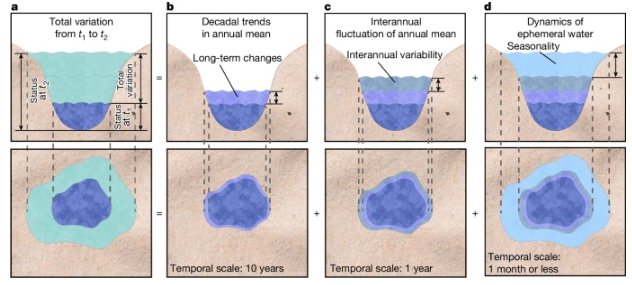
2025年5月28日,清华大学Di Long团队在《自然》杂志发表论文,他们提出了季节性在形成湖面范围动态中的全球主导地位。
湖泊对生态系统、温室气体排放和水资源至关重要,但由于卫星观测的局限性,从大陆到全球范围内对湖泊的地表范围动态,特别是季节性,仍然知之甚少。尽管之前的研究侧重于长期变化,但对季节性的全面评估受到单源卫星数据中空间分辨率和时间分辨率之间权衡的限制。
研究组表明季节性是全球湖面范围变化的主要驱动因素。通过利用MODIS和Landsat数据集的基于深度学习的时空融合,结合高性能计算,研究组实现了每月1.4 百万个湖泊(2001-2023)的分析。 当与全球地表水数据集进行验证时,该方法分别产生了93%和96%的流域级中值用户和生产者准确率。
季节性湖泊占全球湖泊面积的66%,约占湖泊总数的60%,世界上90%以上的人口居住在此类湖泊盛行的地区。在季节性引发的极端事件中,其影响可能超过23年长期变化和常规季节变化的总和,使42%的萎缩湖泊的收缩翻了一番,并完全抵消了45%的增长湖泊的扩张。
这些结果揭示了以前隐藏的季节动态,这对于理解水圈对环境变化的反应、保护湖泊系统和改进全球气候模型至关重要。该研究结果强调了将季节性纳入未来研究的重要性,并表明多源遥感数据融合的进步提供了一条有前景的前进道路。
附:英文原文
Title: Global dominance of seasonality in shaping lake-surface-extent dynamics
Author: Li, Luoqi, Long, Di, Wang, Yiming, Woolway, R. Iestyn
Issue&Volume: 2025-05-28
Abstract: Lakes are crucial for ecosystems1, greenhouse gas emissions2 and water resources3, yet their surface-extent dynamics, particularly seasonality, remain poorly understood at continental to global scales owing to limitations in satellite observations4,5. Although previous studies have focused on long-term changes6,7,8, comprehensive assessments of seasonality have been constrained by trade-offs between spatial resolution and temporal resolution in single-source satellite data. Here we show that seasonality is the dominant driver of lake-surface-extent variations globally. By leveraging a deep-learning-based spatiotemporal fusion of MODIS and Landsat-based datasets, combined with high-performance computing, we achieved monthly mapping of 1.4million lakes (2001–2023). Our approach yielded basin-level median user’s and producer’s accuracies of 93% and 96%, respectively, when validated against the Global Surface Water dataset7. Seasonality-dominated lakes constitute 66% of the global lake area and approximately 60% of total lake counts, with over 90% of the world’s population residing in regions where such lakes prevail. During seasonality-induced extreme events, the impacts can exceed the combined magnitude of 23-year long-term changes and regular seasonal variations, doubling the contraction of 42% of shrinking lakes and fully offsetting the expansion of 45% of growing lakes. These results uncover previously hidden seasonal dynamics that are crucial for understanding hydrospheric responses to environmental changes9, protecting lacustrine systems10,11,12 and improving global climate models13,14. Our findings underscore the importance of incorporating seasonality into future research and suggest that advancements in the fusion of multisource remote-sensing data offer a promising path forward.
DOI: 10.1038/s41586-025-09046-3
Source: https://www.nature.com/articles/s41586-025-09046-3
Nature:《自然》,创刊于1869年。隶属于施普林格·自然出版集团,最新IF:69.504
官方网址:http://www.nature.com/
投稿链接:http://www.nature.com/authors/submit_manuscript.html
